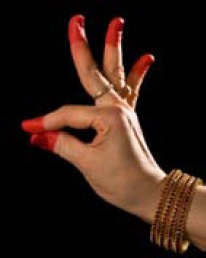Bharatanatyam, a classical Indian dance form, uses a wide range of mudras or hand gestures to convey various meanings and emotions. Here are some commonly used mudras in Bharatanatyam:
- Anjali: This is a gesture of folded hands that is used to express greeting, prayer, or respect.

- Tripataka: This mudra is formed by extending the three fingers of the hand while keeping the other fingers bent. It is used to convey the ideas of fire, wind, or tree.

- Ardhachandra: This mudra is formed by bending the ring finger and extending the other fingers. It is used to depict the crescent moon or to show a woman’s face.

- Hamsasya: This mudra forms a swan with the hands and is used to depict a swan or bird in flight.

- Alapadma: This mudra is formed by joining the tips of the thumb, index finger, and middle finger to create a lotus-like shape. It is used to depict flowers or to express beauty.

- Shikhara: This mudra is formed by joining the tips of the thumb, index finger, and middle finger while keeping the other fingers bent. It is used to depict a mountain or to express strength.
- Asamyukta hasta: This is a single-hand gesture that is used to depict various objects or animals, such as a deer, snake, or flower.

There are many other mudras in Bharatanatyam, each with its own specific meaning and usage. The precise and intricate use of mudras is what makes Bharatanatyam such a rich and expressive dance form.
